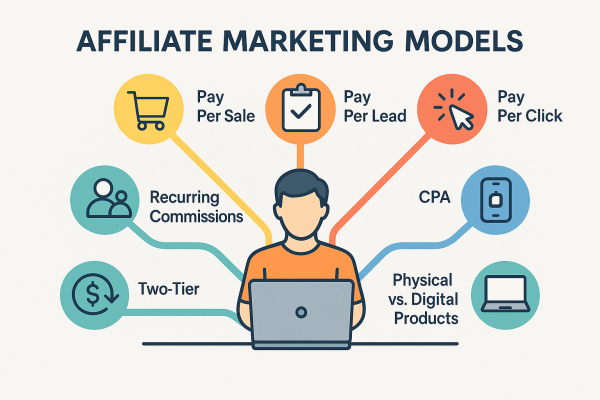
What Kinds of Affiliate Marketing Models Are There?
If you’ve been poking around in affiliate marketing for a while, you’ve probably noticed that people throw around terms like CPA, CPL, or Rev Share like everyone already knows what they mean. Truth is — there are several different affiliate marketing models, and knowing the differences can save you a lot of confusion (and help you pick the one that actually fits you best).
Let’s break them down in plain English.
1. Pay Per Sale (PPS)
This is the classic model. You earn a commission only when someone buys a product or service through your affiliate link.
- Example: You promote a $100 course, and you earn 30% ($30) if someone purchases.
- Best For: Bloggers, content creators, or anyone building trust and recommending products they’ve actually used.
2. Pay Per Lead (PPL / CPL)
Here you earn money when someone signs up, fills out a form, or requests more info — no purchase needed.
- Example: A company pays you $2–$10 for every person who fills in their email on a free trial page.
- Best For: Email list builders, lead-gen focused marketers, or people targeting niches where companies need lots of leads (finance, insurance, SaaS).
3. Pay Per Click (PPC)
You’re paid just for sending traffic — every click through your link counts.
- Example: You earn $0.05–$0.20 each time someone clicks your affiliate link.
- Best For: High-traffic sites or ad-based marketers. Not as common these days because advertisers want quality, not just clicks.
4. Cost Per Action (CPA)
This is broader — you get paid when the user takes any specific action. Could be installing an app, watching a video, or starting a free trial.
- Example: You earn $3 if someone installs a mobile game app through your link.
- Best For: Social media ads, YouTube reviews, and sites where quick actions are common.
5. Recurring / Subscription Commissions
Instead of a one-time payout, you keep earning as long as the customer stays subscribed.
- Example: Promote a $49/month software tool and earn 30% ($14.70) every month the customer stays on.
- Best For: Affiliates looking to build passive, predictable income streams (my personal favorite model).
6. Two-Tier / Multi-Level Commissions
You earn on your sales and a small percentage of the sales made by people you referred as affiliates.
- Example: You promote a program, and your friend joins as an affiliate. You get a slice of their commissions too.
- Best For: Networkers and community builders. (But beware — this is not the same as MLM schemes; legit affiliate programs simply reward referrals fairly.)
7. Physical Product vs. Digital Product Models
- Physical Products: Think Amazon Associates — lower commissions (1–10%), but people trust and buy more easily.
- Digital Products: Courses, software, eBooks — higher commissions (30–70%), but sometimes harder to sell.
- Best For: Depends on your niche — some people thrive on Amazon’s huge variety, while others prefer high-ticket digital offers.
Wrapping It Up
The affiliate model you choose should match both your audience and your own strengths.
- Love creating content and building trust? Pay Per Sale / Recurring models might be for you.
- Prefer quick wins and traffic-heavy strategies? CPL or CPA could fit.
- Want something steady? Recurring commissions can create long-term income streams.
The real trick? Pick one model to focus on first. Master it, then branch out.
